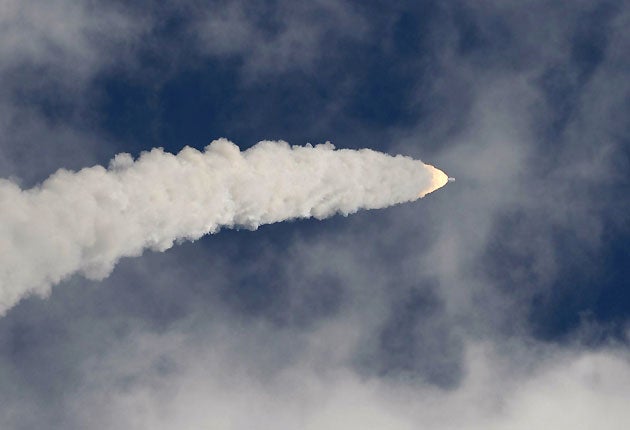$445m for Nasa's six-minute test flight

Your support helps us to tell the story
From reproductive rights to climate change to Big Tech, The Independent is on the ground when the story is developing. Whether it's investigating the financials of Elon Musk's pro-Trump PAC or producing our latest documentary, 'The A Word', which shines a light on the American women fighting for reproductive rights, we know how important it is to parse out the facts from the messaging.
At such a critical moment in US history, we need reporters on the ground. Your donation allows us to keep sending journalists to speak to both sides of the story.
The Independent is trusted by Americans across the entire political spectrum. And unlike many other quality news outlets, we choose not to lock Americans out of our reporting and analysis with paywalls. We believe quality journalism should be available to everyone, paid for by those who can afford it.
Your support makes all the difference.Nasa's newest rocket blasted off on a brief test flight today, taking the first step in a back-to-the-moon program that could yet be shelved by the White House.
The 327-foot (100-meter) Ares I-X rocket resembled a giant white pencil as it shot into the sky, delayed a day by poor weather.
Nearly twice the height of the spaceship it's supposed to replace — the shuttle — the skinny experimental rocket carried no passengers or payload, only throwaway ballast and hundreds of sensors. The flight cost $445 million.
Nasa said the test was successful, based on early indications.
"Oh, man. Well, how impressive is that," said Jeff Hanley, manager of Nasa's space frontier program, known as Constellation. "You've accomplished a great step forward for exploration," he told launch controllers.
It was the first time in nearly 30 years that a new rocket took off from Kennedy Space Center. Columbia made the maiden voyage for the shuttle fleet back in 1981.
Liftoff, in fact, occurred 48 years and one day after the first launch of a Saturn rocket, a precursor to what carried astronauts to the moon during the Apollo program. The Saturn V moon rockets were the tallest ever built, an impressive 363 feet (111 meters).
Wednesday's launch, years in the making, attracted a large crowd.
The prototype moon rocket took off through a few clouds from a former shuttle launch pad at 11:30 a.m. (1530 GMT), 3½ hours late because of bad weather. Launch controllers had to retest the rocket systems after more than 150 lightning strikes were reported around the pad overnight. Then they had to wait out interfering rain clouds, the same kind that thwarted yesterday's attempt.
The ballistic flight did not come close to reaching space and, as expected, lasted a mere two minutes. That's how long it took for the first-stage solid-fuel booster to burn out and separate from the mock upper stage. But it will take months to analyze all the data from the approximately 725 pressure, strain and acceleration sensors.
The maximum altitude of the rocket was not immediately known, but had been expected to be 28 miles (45 kilometers). Parachutes popped open to drop the booster into the Atlantic, where recovery ships waited.
The upper portion of the rocket - all fake parts - fell uncontrolled into the ocean. Those pieces were never meant to be retrieved.
It was all over in six minutes.
"Think about what we just did. Our first flight test and the only thing we're waiting on was weather," launch director Ed Mango told his team.
Wednesday's launch represented the first step in Nasa's effort to return astronauts to the moon. The White House, though, is re-evaluating the human spaceflight program and may dump the Ares I in favor of another type of rocket and possibly another destination.
Nasa contends the Ares I will be ready to carry astronauts to the International Space Station in 2015, four to five years after the shuttles are retired. But a panel of experts said in a report to President Barack Obama last week that it will be more like 2017, and stressed that the entire effort is underfunded.
The first Ares moon trip would be years beyond that under the current plan.
No matter what happens, Nasa managers said they will learn a lot from this experimental flight, even if it's for another type of rocket.
"A lot of the gold that we had to mine in doing this Ares I-X test flight, we've already realized in the people," Hanley said earlier this week. "The investment that we've made and the people and the learning is preparing us to do whatever the nation asks this team to do in the months and years ahead."
Join our commenting forum
Join thought-provoking conversations, follow other Independent readers and see their replies
Comments